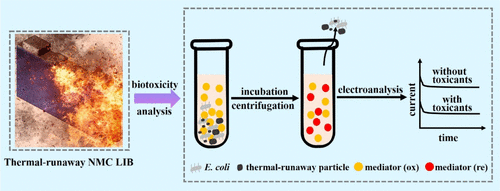当前位置:
X-MOL 学术
›
ACS Appl. Energy Mater.
›
论文详情
Our official English website, www.x-mol.net, welcomes your
feedback! (Note: you will need to create a separate account there.)
Characterization of Thermal-Runaway Particles from Lithium Nickel Manganese Cobalt Oxide Batteries and Their Biotoxicity Analysis
ACS Applied Energy Materials ( IF 5.4 ) Pub Date : 2021-09-21 , DOI: 10.1021/acsaem.1c01711 Yajie Yang 1, 2 , Deyu Fang 3 , Afshin Maleki 4 , Shadi Kohzadi 4 , Yanran Liu 1, 2 , Yafei Chen 1, 2 , Runze Liu 1, 5 , Guanyue Gao 1, 2 , Jinfang Zhi 1, 2
ACS Applied Energy Materials ( IF 5.4 ) Pub Date : 2021-09-21 , DOI: 10.1021/acsaem.1c01711 Yajie Yang 1, 2 , Deyu Fang 3 , Afshin Maleki 4 , Shadi Kohzadi 4 , Yanran Liu 1, 2 , Yafei Chen 1, 2 , Runze Liu 1, 5 , Guanyue Gao 1, 2 , Jinfang Zhi 1, 2
Affiliation

|
Thermal runaway is one of the main causes of lithium-ion battery failure or even explosion, accompanied by the leakage of toxic substances into the environment. In the present work, a severe thermal-runaway process of commercialized LiNi0.6Mn0.2Co0.2O2 and LiNi0.8Mn0.1Co0.1O2 batteries was simulated, and the biohazards of the produced particles were discussed. Composition analysis revealed that thermal-runaway particles contained multiple toxic metallic and nonmetallic elements (Ni, Co, Mn, Al, Cu, S, Si, P, and F), accompanied by valence changes of Ni, Co, and Cu. More importantly, a typical microorganism, Escherichia coli, was chosen as the test organism, and the biotoxicity of thermal-runaway particles was assessed by the electrochemical method. Corresponding pristine cathode materials were analyzed and compared simultaneously. The results indicated that the thermal-runaway particles would cause instant inhibitions on bacterial respiratory activities in the range of 25–200 mg/L, and cell membrane damages were observed after exposure to thermal-runaway particles for 5 h, whereas the corresponding pristine cathode materials only exhibited minor effects on bacterial activities in the same conditions. Moreover, no significant inhibitory impacts were detected in thermal-runaway particles’ supernatants, which excluded ion dissolution as a major factor to bacterial toxicity in the short time period. The generation of the superoxide anion indicated a dominant role of reactive oxygen species in the biotoxicity of thermal-runaway particles. The present study focuses on the toxic effect of particles from the thermal-runaway process of lithium-ion batteries, which has significant implications for spent batteries disposal and environment protection.
中文翻译:

锂镍锰钴氧化物电池热失控粒子的表征及其生物毒性分析
热失控是导致锂离子电池失效甚至爆炸的主要原因之一,伴随着有毒物质泄漏到环境中。在目前的工作中,模拟了商业化的 LiNi 0.6 Mn 0.2 Co 0.2 O 2和 LiNi 0.8 Mn 0.1 Co 0.1 O 2电池的严重热失控过程,并讨论了所产生颗粒的生物危害。成分分析表明,热失控颗粒含有多种有毒金属和非金属元素(Ni、Co、Mn、Al、Cu、S、Si、P 和 F),并伴有 Ni、Co 和 Cu 的价态变化。更重要的是,一个典型的微生物,大肠杆菌, 被选为试验生物,并通过电化学方法评估热失控颗粒的生物毒性。同时对相应的原始正极材料进行了分析和比较。结果表明,热失控颗粒在 25-200 mg/L 范围内会立即抑制细菌呼吸活动,并且在暴露于热失控颗粒 5 h 后观察到细胞膜损伤,而相应的原始阴极在相同条件下,材料对细菌活性的影响很小。此外,在热失控颗粒的上清液中没有检测到显着的抑制作用,这排除了离子溶解是短时间内细菌毒性的主要因素。超氧阴离子的产生表明活性氧在热失控颗粒的生物毒性中起主导作用。本研究侧重于锂离子电池热失控过程中颗粒的毒性作用,这对废电池处理和环境保护具有重要意义。
更新日期:2021-10-25
中文翻译:

锂镍锰钴氧化物电池热失控粒子的表征及其生物毒性分析
热失控是导致锂离子电池失效甚至爆炸的主要原因之一,伴随着有毒物质泄漏到环境中。在目前的工作中,模拟了商业化的 LiNi 0.6 Mn 0.2 Co 0.2 O 2和 LiNi 0.8 Mn 0.1 Co 0.1 O 2电池的严重热失控过程,并讨论了所产生颗粒的生物危害。成分分析表明,热失控颗粒含有多种有毒金属和非金属元素(Ni、Co、Mn、Al、Cu、S、Si、P 和 F),并伴有 Ni、Co 和 Cu 的价态变化。更重要的是,一个典型的微生物,大肠杆菌, 被选为试验生物,并通过电化学方法评估热失控颗粒的生物毒性。同时对相应的原始正极材料进行了分析和比较。结果表明,热失控颗粒在 25-200 mg/L 范围内会立即抑制细菌呼吸活动,并且在暴露于热失控颗粒 5 h 后观察到细胞膜损伤,而相应的原始阴极在相同条件下,材料对细菌活性的影响很小。此外,在热失控颗粒的上清液中没有检测到显着的抑制作用,这排除了离子溶解是短时间内细菌毒性的主要因素。超氧阴离子的产生表明活性氧在热失控颗粒的生物毒性中起主导作用。本研究侧重于锂离子电池热失控过程中颗粒的毒性作用,这对废电池处理和环境保护具有重要意义。









































 京公网安备 11010802027423号
京公网安备 11010802027423号